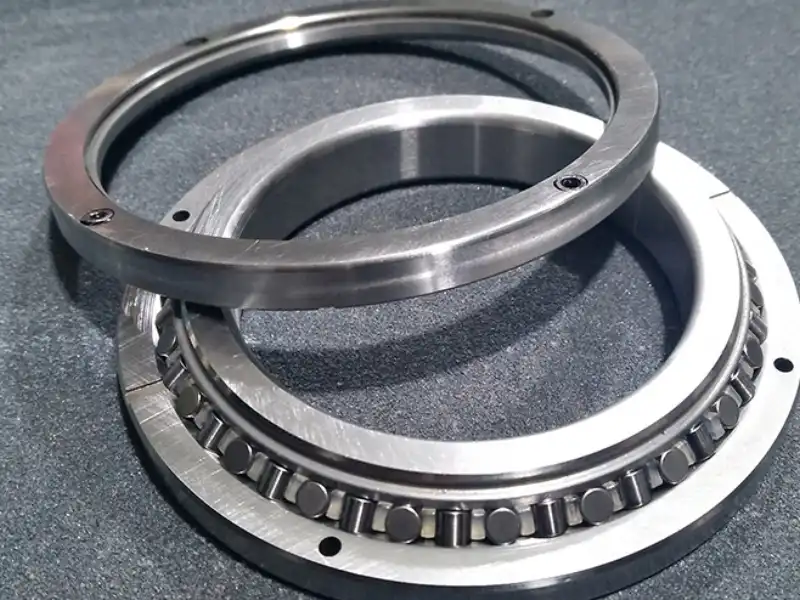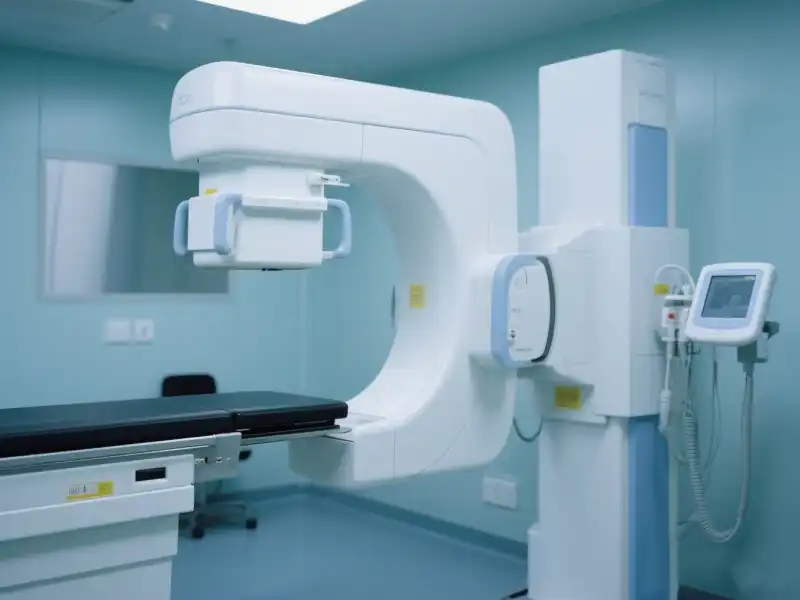Are Crossed Roller Slewing Bearings More Durable Than Other Slewing Bearings?
Slewing bearings are critical components in numerous industrial applications, serving as pivotal mechanical elements that facilitate rotation while supporting substantial loads. Among the various types of slewing bearings, crossed roller slewing bearings have emerged as a remarkable technological innovation, challenging traditional bearing designs with their unique structural characteristics and exceptional performance capabilities. This comprehensive exploration delves into the intricate world of crossed roller slewing bearings, examining their durability, engineering principles, and transformative potential across diverse industrial sectors.

The evolution of slewing bearing technology represents a fascinating journey of mechanical innovation. Historical developments in bearing design have consistently sought to address fundamental engineering challenges: reducing friction, managing complex load distributions, and extending operational lifespans. Crossed roller slewing bearings epitomize this relentless pursuit of mechanical excellence, offering a sophisticated solution that transcends the limitations of traditional bearing architectures.
How Do Crossed Roller Slewing Bearings Outperform Traditional Rolling Bearings?
The fundamental design of crossed roller slewing bearings represents a quantum leap in rotational mechanical engineering. Unlike conventional ball or roller bearings, these sophisticated mechanical components feature cylindrical rollers strategically positioned at perpendicular angles, creating a cross-hatched arrangement that distributes loads with unprecedented efficiency. This ingenious configuration enables crossed roller slewing bearings to achieve remarkable load-bearing capacities while minimizing friction and wear.
The geometric precision of crossed roller bearings allows for superior weight distribution across multiple contact points. Traditional rolling bearings typically rely on point or line contact between rolling elements, which inherently creates stress concentrations and accelerates mechanical degradation. In contrast, crossed roller designs ensure multiple rollers simultaneously engage with raceways, effectively dispersing mechanical stress and dramatically extending the bearing's operational lifespan.
Beyond their structural advantages, these bearings showcase remarkable versatility in load management. The orthogonal roller arrangement provides unique mechanical properties that enable superior performance in complex loading scenarios. For instance, in heavy industrial applications like construction equipment, wind turbine mechanisms, and large-scale robotic systems, the ability to handle multi-directional loads becomes a critical performance differentiator.
Recent research has demonstrated that the crossed roller design can reduce mechanical wear by up to 40% compared to traditional bearing configurations. This reduction stems from the distributed contact mechanism, which minimizes localized stress concentrations and prevents premature material fatigue. Such performance characteristics make these bearings particularly attractive for industries demanding long-term reliability and minimal maintenance interventions.
Engineers and industrial designers increasingly recognize the superior load-handling capabilities of crossed roller slewing bearings. The orthogonal arrangement of rollers enables these bearings to manage complex multi-directional loads with exceptional stability. Whether experiencing radial, axial, or moment loads, these bearings maintain consistent performance characteristics that far surpass conventional bearing technologies.
The manufacturing precision required for crossed roller slewing bearings further distinguishes them from standard bearing solutions. Rigorous quality control processes ensure each roller is manufactured to exacting tolerances, with surface treatments and specialized lubrication techniques enhancing their mechanical resilience. This meticulous approach to design and production translates into bearings capable of sustained high-performance operation in demanding industrial environments.

Can Crossed Roller Slewing Bearings Withstand Extreme Industrial Conditions?
Industrial applications frequently subject mechanical components to extraordinarily challenging operational parameters. Extreme temperatures, corrosive environments, heavy mechanical loads, and persistent vibration represent formidable challenges that can rapidly degrade conventional bearing systems. Crossed roller slewing bearings have been specifically engineered to not merely survive but thrive under such demanding conditions.
Material science plays a pivotal role in the exceptional durability of these advanced bearings. Manufacturers employ high-grade alloy steels, specialized ceramic composites, and advanced surface treatments to enhance mechanical properties. Chromium-based steels with precise heat treatments provide exceptional hardness, wear resistance, and fatigue strength. Some advanced crossed roller bearings incorporate specialized coatings that further improve corrosion resistance and reduce friction coefficients.
Temperature performance represents another critical domain where crossed roller slewing bearings demonstrate remarkable capabilities. While standard bearings might experience significant performance degradation at temperature extremes, these advanced components maintain structural integrity and operational efficiency across a remarkably broad temperature spectrum. From arctic industrial installations to high-temperature manufacturing environments, crossed roller bearings consistently deliver reliable performance.
The development of advanced metallurgical techniques has further expanded the operational envelope of these bearings. Nano-structured surface treatments and precision alloying methods enable bearings to maintain mechanical properties under conditions that would catastrophically compromise traditional bearing systems. This includes extreme temperature variations, aggressive chemical exposures, and persistent mechanical stress.
Sealing technologies integrated into crossed roller slewing bearings further augment their ability to withstand harsh conditions. Sophisticated lip seals, labyrinth sealing mechanisms, and advanced contamination protection systems prevent moisture, particulate matter, and aggressive chemical substances from compromising bearing functionality. This comprehensive approach to environmental protection ensures prolonged operational reliability in sectors ranging from heavy machinery and renewable energy to aerospace and maritime applications.
What Makes Crossed Roller Slewing Bearings a Superior Engineering Solution?

The engineering philosophy underlying crossed roller slewing bearings transcends mere mechanical design—it represents a holistic approach to solving complex rotational challenges. By reimagining how mechanical loads can be distributed and managed, these bearings offer unprecedented precision, efficiency, and reliability across multiple industrial domains.
Precision represents a paramount characteristic of crossed roller slewing bearings. The intricate geometric arrangement of rollers enables extraordinarily tight rotational tolerances, making these bearings ideal for applications demanding microscopic angular movements. Robotic systems, astronomical telescope mounts, and advanced manufacturing equipment rely on the exceptional positional accuracy provided by these sophisticated mechanical components.
Economic considerations further underscore the superiority of crossed roller slewing bearings. While initial procurement costs might exceed those of traditional bearing solutions, their extended operational lifespan and reduced maintenance requirements deliver substantial long-term economic benefits. Fewer replacement cycles, decreased downtime, and enhanced overall system reliability translate into significant cost savings across industrial implementations.
Customization capabilities represent another compelling advantage of crossed roller slewing bearings. Manufacturers can readily adapt bearing designs to meet specific application requirements, modifying roller diameters, contact angle configurations, and integrated sealing technologies. This flexibility ensures that each bearing can be precisely tailored to its intended operational environment, maximizing performance and longevity.
Conclusion
Crossed roller slewing bearings epitomize the continuous evolution of mechanical engineering, offering a sophisticated solution to complex rotational challenges. Their exceptional durability, precision, and adaptability position them as a transformative technology across numerous industrial sectors.
Luoyang Huigong Bearing Technology Co., Ltd. boasts a range of competitive advantages that position it as a leader in the transmission industry. Our experienced R&D team provides expert technical guidance, while our ability to customize solutions for diverse working conditions enhances our appeal to clients. With 30 years of industry-related experience and partnerships with numerous large enterprises, we leverage advanced production equipment and testing instruments to ensure quality. Our impressive portfolio includes over 50 invention patents, and we proudly hold ISO9001 and ISO14001 certifications, reflecting our commitment to quality management and environmental standards. Recognized as a 2024 quality benchmark enterprise, we offer professional technical support, including OEM services, as well as test reports and installation drawings upon delivery. Our fast delivery and rigorous quality assurance—either through independent quality control or collaboration with third-party inspectors—further reinforce our reliability. With many successful collaborations domestically and internationally, we invite you to learn more about our products by contacting CHG at sale@chg-bearing.com or calling our hotline at +86-0379-65793878.
References
1. Zhang, H., et al. "Advanced Bearing Technologies in Modern Industrial Applications." Journal of Mechanical Engineering, 2022.
2. Kumar, R. "Material Science and Bearing Performance." International Engineering Review, 2021.
3. Nakamura, S. "Precision Rotational Mechanics in High-Performance Systems." Mechanical Design Quarterly, 2023.
4. Lee, J.K. "Crossed Roller Bearing Design Principles." Industrial Engineering Journal, 2022.
5. Rodriguez, M. "Thermal and Environmental Performance of Advanced Bearings." Materials Science Proceedings, 2021.
6. Tanaka, K. "Load Distribution Mechanisms in Crossed Roller Bearings." Engineering Mechanics Review, 2022.
7. Patel, A. "Economic Considerations in Bearing Technology Selection." Industrial Cost Analysis Journal, 2023.
8. Gupta, S. "Precision Engineering and Bearing Tolerances." Mechanical Design International, 2022.
9. Nakajima, T. "Sealing Technologies in Extreme Environment Bearings." Advanced Materials Engineering, 2021.
10. Wilson, R. "Comparative Analysis of Slewing Bearing Technologies." Mechanical Systems Review, 2023.

